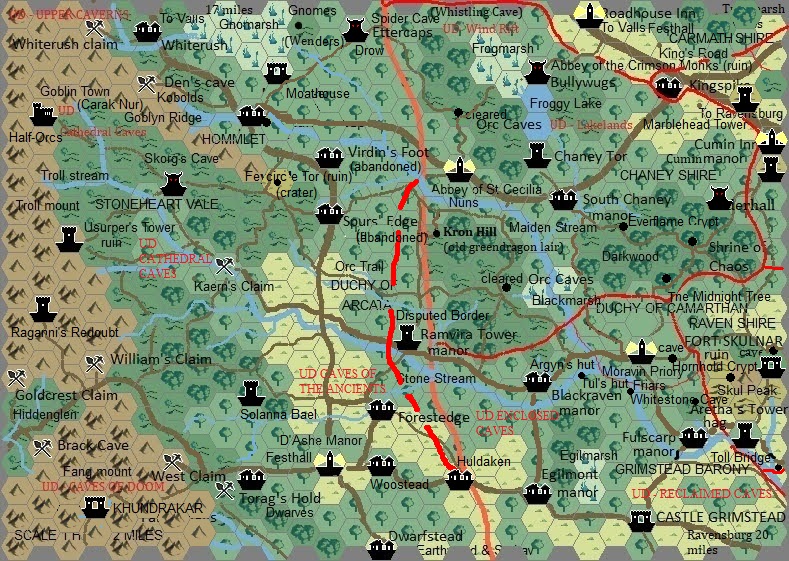Crafting is a big focus IMC, I use the Xanathar's rules with the DMG level limits. A recent influx of dragons due to events in the north has resulted in an explosion of dragon-related item crafting

- eg Fraener (PC) dwarf lord of Khundrakar recently sent white dragon hide to Nathia (PC) the Goliath leathersmith of Ironwolf Manor with an order for
Boots of the Winterlands. Over the last 17 months of play the PCs have accumulated a lot of found and crafted magic items, this somewhat replaces Feats as a PC build element, and can help with PC survivability. More importantly perhaps, hunting dragons and other monsters for their hide & other components is a nice PC-directed activity/goal.
The current Ironwolf/Skulnar group:
Greeba of Soravia (Jelena) Half-Orc female
Barbarian-6 (Berserker) XP 17,280/23,000
AC 20 (half plate, shield +1, DEX+2)
HP 59 (14+9/level) P-PER 10 P-INV 9 P-INS 13
+1 warhammer; flametongue longsword (a), shield +1
Gorlock the Warlock (Tony) Half-Elf male Celestial
Warlock-6 XP 17,280/23,000
AC 15 HP 51 (11+8/level) P-PER 11 P-INV 11 P-INS 11. MI:
Rod of the Pact Keeper +1 (a), Cloak of Protection (a), periapt of wound closure (a)
Eamon of the Yellow Rose (Bill) Human male
Monk-6 (Kensai) XP 16,826/23,000
AC 16/18 HP 39 (9+6/lvl) P-PER 12 P-INV 10 P-INS 15 MI:
+1 longsword, gloves of thievery
Wisteria of Skullspire (Jelly) Moon Elf female Grave
Cleric-6 XP 15,838/23,000
AC 19 HP 45 (10+7/lvl) P-PER 16 P-INV 12 P-INS 16. MI:
+1 longbow, +1 dagger
Nathia Truefist (Kim) Goliath female
Fighter-5 (Champion) XP 12,454/14,000
AC 20 (plate, defence style, cloak)
HP 49 (13+9/lvl) P-PER 13 P-INV 9 P-INS 10 MI:
+1 Shadowfey Guardian Pike (2d8), +1 war pick, Driftglobe, cloak of protection (a), +2 goliath greatsword
Joell Elderberry (Max) Aasimar male Companion of the Noble Heart
Paladin-5 (Oath of Conquest) XP 10,054/14,000
AC 23 (plate & +1 shield, cl (a)oak, defence style)
HP 39 (11+7/lvl) P-PER 11 P-INV 9 P-INS 11 MI:
+1 longsword, +1 shield, cloak of protection (a)
Blurb (Phil) Firbolg male Shepherd
Druid-5 XP 7,805/14,000
AC 20 (ankheg half plate)
HP 38 (10+7/lvl) P-PER 16 P-INV 10 P-INS 14 MI:
shield +1, brooch of shielding
Mac (Matt) Half Elf male Companion of the Noble Heart
Paladin-4 (Oath of Vengeance) XP 6,803/6,500
AC 21 HP 36 (12+8/lvl) P-PER 13 P-INV 10 P-INS 11. MI: 'Metallica'
+1 longsword of poison resistance (a), 'Hammer of justice' +1 warhammer, adamantine plate armour, boots of striding & springing (a)
The current D'Ashe Manor/Norrin's Band group:
Prince Strohm of Leth, Lord of Solanna Bael (Muiz) Sun Elf male Fighter-7 (Eldritch Knight) XP 33,726/34,000 AC 21 (orog plate, shield, defence style) HP 67 (13+9/lvl) P-PER 12 P-INV 12 P-INS 9. MI: +2 Scimitar of Speed (A), +2 Greatsword - Excruciator, the Sword of Amaul, aka the Sword of the Sorcerer (sheds light as per spell on command)
Sir Norrin, Son of Thorin (Geoff) Human male
Fighter-7 (Champion) PB+3 XP 31,895/34,000
AC 23 (plate +1 & shield +2)
HP 67 (13+9/level)
P-PER 15 P-INV 12
P-INS 15 MI:
+1 Nar 'hero sword' longsword, +1 plate armour, +2 shield
Malied Edicast (James) Half-Elf male Wizard-7 XP 28,377/34,000 AC 16 (elven chain) HP 30 (6+4/lvl) P-PER 14 P-INV 18 P-INS 11. Blessing: +2 INT from Gina the Gynosphinx. Helm of Comprehending Languages, Ring of Spell Storing (a), hat of wizardry (a), JAODAR’S TOME OF ENCHANTMENT (a), +1 elven chain shirt
Fraener ap Durgeddin, Lord of Khundrakar (Chris) Mountain Dwarf male Forge Cleric-7 XP 26,006/34,000 AC 24 (AC 19 plate armour +1, +4 for +2 shield, +1 soul of the forge) HP 66 (12+9/lvl), fire resistance P-PER 12 P-INV 10 P-INS 15. MI:
Boots of Striding & Springing spd 30' (a); Durgeddin's own
+1 full plate armour (+0/
+1 at 5th level),
+2 Durgeddin shield, the
Hammer of Cirdan Man-friend +3 dwarven thrower (a). MI with his Huscarls:
+1 Duergar warhammer, +1 battle axe, +1 hand axe
Queale (Keelia) Half-Elf female Horizon Walker Ranger-6 XP 20,255/23,000 AC 17 (mithril half plate) HP 58 (13+9/level) P-PER 16 P-INV 13 P-INS 16 MI: cute rabbit fur slippers of elvenkind, +1 arrows, ethereal diadem (in pack, a), +1 longbow, Oathbow (a), +1 Durgeddin Rapier
Ted of Goblin Town (Matt) Half-Orc male Assassin Rogue-6 XP 18,895/23,000 AC 17 (+1 studded) HP 45 (10+7/lvl) P-PER 17 P-INV 9 P-INS 11 MI: Ostrikka's/Jack's gauntlets of ogre power STR 19 (a), Barbara's Rope of Climbing, wand of magic missiles, cloak of elvenkind (a), 2 +1 shortswords, +1 studded leather
Meryem Bloodletter of Reghed (Roxy) Human female Berserker
Barbarian-5 XP 11,151/14,000
AC 20 (15 half plate +2 DEX +3
shield +1)
HP 55 (15+10/level) P-PER 10 P-INV 10 P-INS 10. MI:
+1 Duergar greatsword, +3 battleaxe of Durgeddin, +1 shield
The latter group have mostly been around somewhat longer, and have been more successful - with fewer defeats and lost PCs. They've been able to complete more challenging adventures, hence their greater magic items tally.




